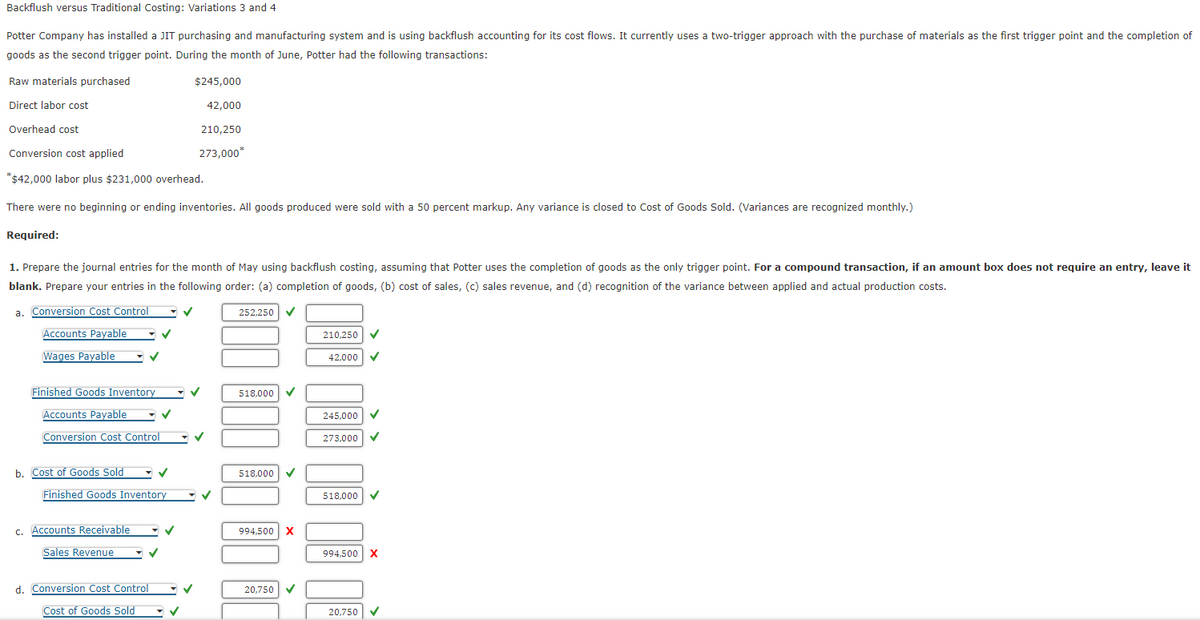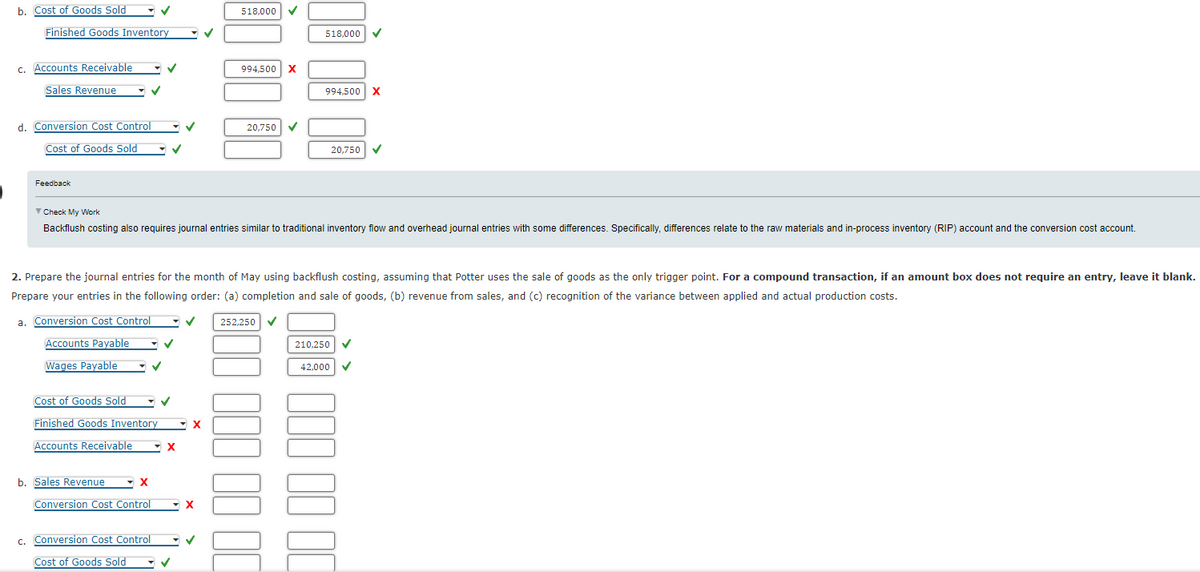Potter Company has installed a JIT purchasing and manufacturing system and is using backflush accounting for its cost flows. It currently uses a two-trigger approach with the purchase of materials as the first trigger point and the completion goods as the second trigger point. During the month of June, Potter had the following transactions: Raw materials purchased $245,000 Direct labor cost 42,000 210,250 273,000" Overhead cost Conversion cost applied "$42,000 labor plus $231,000 overhead. There were no beginning or ending inventories. All goods produced were sold with a 50 percent markup. Any variance is closed Cost of Goods Sold. (Variances are recognized monthly.) Required: 1. Prepare the journal entries for the month of May using backflush costing, assuming that Potter uses the completion of goods as the only trigger point. For a compound transaction, if an amount box does not require an entry, leave blank. Prepare your entries in the following order: (a) completion of goods, (b) cost of sales, (c) sales revenue, and (d) recognition of the variance between applied and actual production costs. progres
Potter Company has installed a JIT purchasing and manufacturing system and is using backflush accounting for its cost flows. It currently uses a two-trigger approach with the purchase of materials as the first trigger point and the completion goods as the second trigger point. During the month of June, Potter had the following transactions: Raw materials purchased $245,000 Direct labor cost 42,000 210,250 273,000" Overhead cost Conversion cost applied "$42,000 labor plus $231,000 overhead. There were no beginning or ending inventories. All goods produced were sold with a 50 percent markup. Any variance is closed Cost of Goods Sold. (Variances are recognized monthly.) Required: 1. Prepare the journal entries for the month of May using backflush costing, assuming that Potter uses the completion of goods as the only trigger point. For a compound transaction, if an amount box does not require an entry, leave blank. Prepare your entries in the following order: (a) completion of goods, (b) cost of sales, (c) sales revenue, and (d) recognition of the variance between applied and actual production costs. progres
Principles of Cost Accounting
17th Edition
ISBN:9781305087408
Author:Edward J. Vanderbeck, Maria R. Mitchell
Publisher:Edward J. Vanderbeck, Maria R. Mitchell
Chapter2: Accounting For Materials
Section: Chapter Questions
Problem 18E: For E2-17, prepare any journal entries that would have been different if the only trigger points had...
Related questions
Question
Mostly need assistance with 2. Thanks!

Transcribed Image Text:Backflush versus Traditional Costing: Variations 3 and 4
Potter Company has installed a JIT purchasing and manufacturing system and is using backflush accounting for its cost flows. It currently uses a two-trigger approach with the purchase of materials as the first trigger point and the completion of
goods as the second trigger point. During the month of June, Potter had the following transactions:
Raw materials purchased
$245,000
Direct labor cost
Overhead cost
Conversion cost applied
*$42,000 labor plus $231,000 overhead.
There were no beginning or ending inventories. All goods produced were sold with a 50 percent markup. Any variance is closed to Cost of Goods Sold. (Variances are recognized monthly.)
Required:
1. Prepare the journal entries for the month of May using backflush costing, assuming that Potter uses the completion of goods as the only trigger point. For a compound transaction, if an amount box does not require an entry, leave it
blank. Prepare your entries in the following order: (a) completion of goods, (b) cost of sales, (c) sales revenue, and (d) recognition of the variance between applied and actual production costs.
a. Conversion Cost Control
Accounts Payable
Wages Payable
Finished Goods Inventory
Accounts Payable
Conversion Cost Control
b. Cost of Goods Sold
Finished Goods Inventory
c. Accounts Receivable
Sales Revenue
✓
✓
d. Conversion Cost Control
Cost of Goods Sold
✓
✓
✓
42,000
210,250
273,000*
✓
✓
✓
✓
252,250 ✓
518,000 ✓
518,000 ✓
994,500 X
20,750 ✓
210,250
42,000
245,000
273,000
518,000 ✓
994,500 X
20,750 ✔

Transcribed Image Text:b. Cost of Goods Sold
Finished Goods Inventory
c. Accounts Receivable
Sales Revenue
d. Conversion Cost Control
Cost of Goods Sold
Feedback
✓
Accounts Payable
Wages Payable
b. Sales Revenue
X
✓
Conversion Cost Control
✓
Cost of Goods Sold
Finished Goods Inventory ▼ X
Accounts Receivable
c. Conversion Cost Control
✓
Check My Work
Backflush costing also requires journal entries similar to traditional inventory flow and overhead journal entries with some differences. Specifically, differences relate to the raw materials and in-process inventory (RIP) account and the conversion cost account.
X
Cost of Goods Sold - ✓
2. Prepare the journal entries for the month of May using backflush costing, assuming that Potter uses the sale of goods as the only trigger point. For a compound transaction, if an amount box does not require an entry, leave it blank.
Prepare your entries in the following order: (a) completion and sale of goods, (b) revenue from sales, and (c) recognition of the variance between applied and actual production costs.
a. Conversion Cost Control
252,250 ✓
✓
✓
▼ X
518,000 ✓
✓
994,500 X
20,750 ✓
518,000
994,500 X
20,750
210,250 ✓
42,000 ✓
300 00 00
Expert Solution
This question has been solved!
Explore an expertly crafted, step-by-step solution for a thorough understanding of key concepts.
This is a popular solution!
Trending now
This is a popular solution!
Step by step
Solved in 3 steps

Knowledge Booster
Learn more about
Need a deep-dive on the concept behind this application? Look no further. Learn more about this topic, accounting and related others by exploring similar questions and additional content below.Recommended textbooks for you

Principles of Cost Accounting
Accounting
ISBN:
9781305087408
Author:
Edward J. Vanderbeck, Maria R. Mitchell
Publisher:
Cengage Learning

Managerial Accounting
Accounting
ISBN:
9781337912020
Author:
Carl Warren, Ph.d. Cma William B. Tayler
Publisher:
South-Western College Pub

Managerial Accounting: The Cornerstone of Busines…
Accounting
ISBN:
9781337115773
Author:
Maryanne M. Mowen, Don R. Hansen, Dan L. Heitger
Publisher:
Cengage Learning

Principles of Cost Accounting
Accounting
ISBN:
9781305087408
Author:
Edward J. Vanderbeck, Maria R. Mitchell
Publisher:
Cengage Learning

Managerial Accounting
Accounting
ISBN:
9781337912020
Author:
Carl Warren, Ph.d. Cma William B. Tayler
Publisher:
South-Western College Pub

Managerial Accounting: The Cornerstone of Busines…
Accounting
ISBN:
9781337115773
Author:
Maryanne M. Mowen, Don R. Hansen, Dan L. Heitger
Publisher:
Cengage Learning

Cornerstones of Cost Management (Cornerstones Ser…
Accounting
ISBN:
9781305970663
Author:
Don R. Hansen, Maryanne M. Mowen
Publisher:
Cengage Learning

Financial And Managerial Accounting
Accounting
ISBN:
9781337902663
Author:
WARREN, Carl S.
Publisher:
Cengage Learning,

Principles of Accounting Volume 2
Accounting
ISBN:
9781947172609
Author:
OpenStax
Publisher:
OpenStax College